500 Abarth
It is powered by a 1.4 16v Turbo petrol engine which delivers a maximum of 135 bhp at 5000 rpm and peak torque of 206 Nm at 3000 rpm in ‘Sport’ mode (in ‘Normal’ mode the max torque is 180 Nm at 2500 rpm).
This new engine is also relatively environmentally aware, like the regular Fiat model it is derived from, the new Abarth 500 respects future Euro 5 legislation.
An interesting feature of the 500 Abarth is the TTC (Torque Transfer Control) system, which improves the transfer of drive torque to the wheels, but, above all, ensures that the car behaves impeccably on
bends, making it safer and more entertaining to drive when you put your foot down. This system uses differential braking to produce these effects.
Respecting Abarth tradition, the styling of the 500 Abarth is not a mere exercise in aesthetics, but is driven mainly by the need to improve the car’s performance. The 500 Abarth optimises aerodynamic behaviour
with several elements, including a large winged spoiler and a ‘diffuser’ that links up to the underbody,
optimising the airflow output, and involving much of the rear bumper.These latter two elements – the spoiler and the diffuser – help to reduce drag and increase downforce at high speed.
But it is the front that really announces the true performance of the 500 Abarth : the triple air intakes consists of a central inlet, which is larger than on the basic model, with a much broader upper opening (above the
number plate) and the two ‘nostrils’, positioned symmetrically at the sides of the bumper, which correspond exactly to the position of the two identical intercoolers, just visible through the ‘nostrils’, guaranteeing
airflow in and out.
The nose of the car has been extended forward to create the space necessary for the turbocharger; this makes the side view of the 500 Abarth much more pronounced, in harmony with Abarth tradition,
recalling the 850 TC and 1000 TC, on which the externally mounted radiators were immediately visible and recognisable as a characteristic feature of the brand. On this pronounced nose, the Abarth logo, which
appears for the first time without a chrome surround, ‘floats’ on a finned surface that serves as an additional air intake. The Abarth shields positioned on the sides are shot through by a tri-colour arrow, like the
ones on the Abarth 595 and 695 in the 1960s, a symbol of the brand’s racing image. Finally in terms of styling, there are new 16” and 17” wheel rims in different styles.
Following an identical route to the Grande Punto Abarth, an 'Esseesse' kit will become available later.
At the 2008 Mille Miglia, Abarth revealed the 500 Assetto Corse. Designed for a single-make race series, a total of 49 of these were to be built. With the 1.4 16v turbo
engine modified to produce 200bhp, the brakes uprated to large Brembo four-pots and a variety of other changes, as well as the regulation safety equipment (roll-cage, harness, seat, etc)
these were sold as ready-to-compete race cars.
Here there is a gallery of images of this car.
See videos of the 500 Abarth, static & interior (18MB) and driving (6MB).
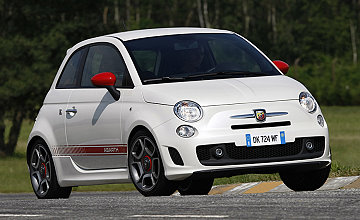 The second car from the relaunched Abarth brand was very eagery awaited. The 500 Abarth, based on the highly successful
Fiat 500, was first shown at the 2008 Geneva Motorshow and has again been significantly modified, more so than the Grande Punto. It went on sale in
Italy in July 2008.
The second car from the relaunched Abarth brand was very eagery awaited. The 500 Abarth, based on the highly successful
Fiat 500, was first shown at the 2008 Geneva Motorshow and has again been significantly modified, more so than the Grande Punto. It went on sale in
Italy in July 2008.
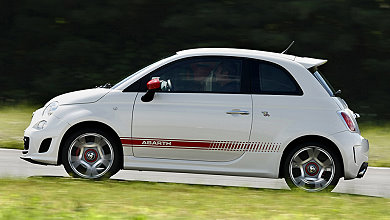 Again, the slots on the front bumper heighten the sporty styling but also perform a critical function, feeding cold air to the two intercoolers positioned at the sides. On either side of the ‘diffuser’, there is
an exhaust pipe that mimics the symmetrical exits of a single transverse silencer (like those in the 1960s). And on the side, sideskirts envelop the curves of the car creating a more vertical profile, which improves
the Cd.
Again, the slots on the front bumper heighten the sporty styling but also perform a critical function, feeding cold air to the two intercoolers positioned at the sides. On either side of the ‘diffuser’, there is
an exhaust pipe that mimics the symmetrical exits of a single transverse silencer (like those in the 1960s). And on the side, sideskirts envelop the curves of the car creating a more vertical profile, which improves
the Cd.
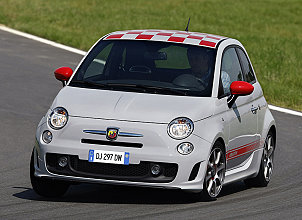 Inside, the cockpit of the 500 Abarth features special instrumentation, derived from that on the Fiat model, to which is added an analogue pressure gauge to show turbo boost pressure. This also incorporates an
LED light that optimises gear changes by lighting up at the appropriate moment. The main instrument panel, with its sports graphics, is protected from glare by an extended upper cowl, while the three-spoke
steering wheel has shaped thumb rests, is ‘flattened’ at the bottom to increase roominess, and is adjustable. The aluminium pedals with their rubber trim have a decidedly ‘racing’ look, like the gearknob (covered
with leather with a more anatomical grip for sporty driving). The same approach is evident in the seats – of the ‘one-piece’ type, incorporating the head-restraint into the squab – which are upholstered with a choice
of materials: fabrics in different combinations of colours and textures, and two versions of leather (black or red). The headlining and the side trims are black, giving the interior a more technical, sporty look.
Inside, the cockpit of the 500 Abarth features special instrumentation, derived from that on the Fiat model, to which is added an analogue pressure gauge to show turbo boost pressure. This also incorporates an
LED light that optimises gear changes by lighting up at the appropriate moment. The main instrument panel, with its sports graphics, is protected from glare by an extended upper cowl, while the three-spoke
steering wheel has shaped thumb rests, is ‘flattened’ at the bottom to increase roominess, and is adjustable. The aluminium pedals with their rubber trim have a decidedly ‘racing’ look, like the gearknob (covered
with leather with a more anatomical grip for sporty driving). The same approach is evident in the seats – of the ‘one-piece’ type, incorporating the head-restraint into the squab – which are upholstered with a choice
of materials: fabrics in different combinations of colours and textures, and two versions of leather (black or red). The headlining and the side trims are black, giving the interior a more technical, sporty look.
Technical Details
| Driveline | transverse engine at front with front wheel drive |
| Engine |
1368cc (72x84mm) 16v dohc turbocharged (IHI turbo) with 135bhp @ 5,500rpm
1368cc (72x84mm) 16v dohc turbocharged with 160bhp @ 5,750rpm with EsseEsse kit |
| Suspension | front : MacPherson strut with telescopic dampers and coil springs plus anti-roll bar
rear : Torsion beam plus anti-roll bar |
| Brakes | front : discs, 284x22mm ventilated
rear : discs, 240x11mm solid handbrake operating on the rear via a cable ABS with EBD |
| Gearbox | 5 speed manual
Hydraulic clutch, cable shift |
| Steering | Rack and pinion with electric power assistance (Dualdrive) |
Performance
| model | max speed | 0-100kph | combined consumption | CO2 emissions |
| 1.4 turbo 135bhp | 205 km/h | 7.9 sec | 5.4 l/100km | 155 g/km |
| 1.4 turbo 160bhp | 211 km/h | 7.4 sec |
There is a list of all our picture galleries (including museums, motorshows and various events).
Wallpapers/Desktop Backgrounds of numerous Fiats also available to download.
500 Abarth comment form
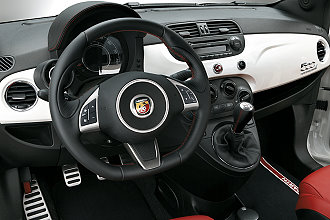
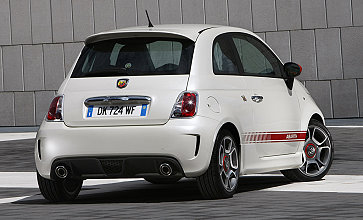
| Grande Punto Abarth | Historic Abarths (unique bodies) |
Historic Abarths (Fiat bodies) | Main Abarth Page |
Copyright © 2000 to 2008 CarsfromItaly